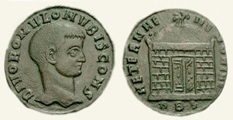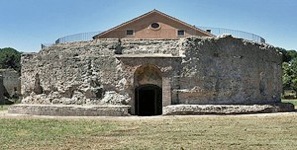DIVO ROMVLO N V BIS CONS: AETERNAE MEMORIAE
RIC VI Rome 207 (ca. 309 AD)
Romulus was the son of Maxentius and the grandson of both Maximian and Galerius. Thus, his death in 309 AD, when he was still only a child, had political as well as personal resonance (as described in the page on Maxentius in Rome: (308-11 AD)).
Maxentius extracted political advantage from the tragedy by consecrating Romulus and minting consecration coins. The deification of imperial children for dynastic purposes was by no means unprecedented: for example, in 284-5 AD, the embattled Emperor Carinus minted not only for his recently-deceased father and brother (divus Carus and divus Numerianus respectively) but also for a young child, divus Nigrinianus (RIC V 471-4), who was probably his son.
The fact that some of these divus Romulus coins were minted in Rome itself suggests that Maxentius had had the consecration ratified by the Senate. (He might well have been following the example of the Emperor Carinus (some of whose coins for the divus Carus and all of whose coins for the divi Numerianus and Nigrinianus were minted in Rome).
Consecration Coins
Maxentius minted two distinct series of coins for divus Romulus, differentiated by their obverse legends:
-
✴DIVO ROMVLO N V BIS CONS (divus Romulus, of most noble rank, twice Consul); and
-
✴IMP MAXENTIVS DIVO ROMVLO N V FILIO (divus Romulus, of most noble rank, son of the Emperor Maxentius).
These coins all had the same reverse legend (usually expressed in the dative): ‘AETERNAE MEMORIAE’ (eternal memory). They were produced at the two mints (Rome and Ostia) that were still in use in Maxentius’ territory coins. They seem to have been essentially chronologically distinct:
-
✴The ‘DIVO ROMVLO N V BIS CON/ AETERNAE MEMORIAE’ coins, which were produced from the time of Romulus’ death, constituted the first divus Romulus series. They are discussed in the following section.
-
✴The ‘IMP MAXENTIVS DIVO ROMVLO N V FILIO/ AETERNAE MEMORIAE’ formed part of a dynastic series that also included coins for the divi Constantius, Maximianus and Galerius probably began after Galerius’ death in April/May 311 AD. They are discussed in my page Maxentius' Consecration Coins (311 AD).
There was, however, a slight degree of overlap between the two series: RIC Rome 257 (see below), which belongs to the first series, had the same mintmark and weight standard as the coins in the dynastic series.
First Series
The first series of coins minted by Maxentius for divus Romulus comprised:
-
✴RIC Rome: 207, illustrated above; 226; 239; 240; and 257; and
-
✴RIC Ostia: 1: 34; 58; and 59.
As noted above, all of these coins had:
-
✴the obverse legend DIVO ROMVLO N V BIS CONS (divus Romulus, of most noble rank, twice consul; and
-
✴the unprecedented reverse legend ‘AETERNAE MEMORIAE’, always in the dative.
They all had a reverse design that depicted a domed structure without columns, which had an eagle above representing the apotheosis of Romulus. As discussed in the page Consecrated Tetrarchs: Mausoleum Coins, I believe that this design represented the mausoleum in the grounds of Maxentius’ villa on the Via Appia (described in the page on Maxentius' Complex on Via Appia). It seems likely that this had been conceived as a dynastic mausoleum, and that Romulus’ early death (probably by accidental drowning in the Tiber) meant that, unexpectedly, he was the first member of the family to be buried in it. (It can be visited, but its dome, if it was ever built, no longer survives).
Read more:
‘RIC’ - see Sutherland (1967) below
I. Sellars, “The Monetary System of the Romans: A Description of the Roman Coinage from Early Times to the Reform of Anastasius”, (2013) Google Books
D. Sear, “Roman Coins”, Volume IV (2011) London
M. Johnson, “The Roman Imperial Mausoleum in Late Antiquity”, (2009) Cambridge
W. Leadbetter, “Galerius and the Will of Diocletian”, (2009 ) London
C. E. V. Nixon and B. S. Rodgers, “In Praise of Later Roman Emperors: The Panegyrici Latini”, (1994) Berkeley
D. Srejovic and C. Vasic, “Emperor Galerius' Buildings in Romuliana (Gamzigrad, Eastern Serbia)”, Antiquité Tardive, 2 (1994) 123-41
M. Johnson, “Where were Constantius I and Helena Buried?”, Latomus, 51 (1992) 145-50
S. MacCormack, “Art and Ceremony in Late Antiquity”, (1981) Berkeley
C. H. V. Sutherland, “Roman Imperial Coinage: Volume VI: From Diocletian’s Reform to the Death of Maximinus (294-313 AD)”, (1967, reprinted 1973) London
Galerius as Augustus II (308-11 AD) Licinius (308-11 AD)
Maxentius in Rome: (308-11 AD) Maxentius' Public Works
Maxentius' Complex on Via Appia Maxentius' Coins for Divus Romulus (309 AD)
Constantine in Gaul (308-11 AD) Constantine, Divus Claudius and Sol Invictus
Consecrated Tetrarchs (306-11 AD) Consecrated Tetrarchs: Mausoleum Coins
Literary Sources : Diocletian to Constantine (285-337 AD)
Return to the History Index





